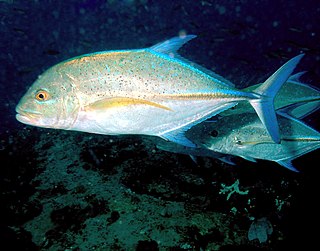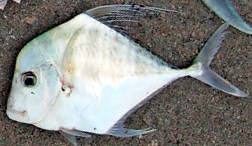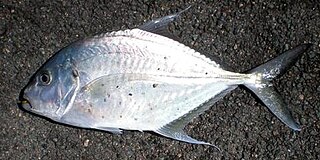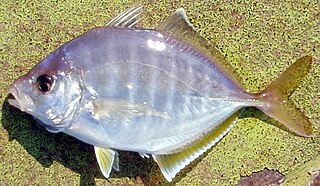
The crevalle jack, also known as the common jack, black-tailed trevally, couvalli jack, black cavalli, jack crevale, or yellow cavalli is a common species of large marine fish classified within the jack family, Carangidae. The crevalle jack is distributed across the tropical and temperate waters of the Atlantic Ocean, ranging from Nova Scotia, Canada to Uruguay in the western Atlantic and Portugal to Angola in the eastern Atlantic, including the Mediterranean Sea. It is distinguishable from similar species by its deep body, fin colouration and a host of more detailed anatomical features, including fin ray and lateral line scale counts. It is one of the largest fish in the genus Caranx, growing to a maximum known length of 124 cm and a weight of 32 kg, although is rare at lengths greater than 60 cm. The crevalle jack inhabits both inshore and offshore waters to depths of around 350 m, predominantly over reefs, bays, lagoons and occasionally estuaries. Young fish dispersed north by currents in the eastern Atlantic are known to migrate back to more tropical waters before the onset of winter; however, if the fish fail to migrate, mass mortalities occur as the temperature falls below the species' tolerance.

The golden trevally, also known as the golden kingfish, banded trevally or king trevally, is a species of large marine fish classified in the jack and horse mackerel family Carangidae, and the only member of the monospecific genus Gnathanodon. The golden trevally is widely distributed throughout the tropical and subtropical waters of the Indian and Pacific Oceans, ranging from South Africa in the west to Central America in the east, extending to Japan in the north and Australia in the south. The species predominantly occupies inshore waters where it inhabits both reef and sandy substrates. The golden trevally is easily distinguished from its relatives by its fleshy, rubbery lips and unique colouration, which ranges from bright yellow with black bars as a juvenile to a golden-silvery colour as an adult. It is known to grow to 120 centimetres (47 in) in length and 15 kilograms (33 lb) in weight. The golden trevally schools as a juvenile, often closely following larger objects including sharks and jellyfish. The species uses its protractile jaws to suck out prey from the sand or reef, and consumes a variety of fish, crustaceans and molluscs. Spawning aggregations gather at night at different times of the year throughout its range. The golden trevally is a considerable constituent of several Middle Eastern fisheries and being of minor importance to many others, with a worldwide annual catch of 1,187 metric tons to 3,475 metric tons recorded between 2000 and 2010. The golden trevally is a popular gamefish, taken by bait, lure, fly and also spear throughout its range. Several Asian countries currently farm the fish in caged aquaculture. Due to their brilliant colouration, juveniles are popular in marine aquaria.

The bigeye trevally, also known as the bigeye jack, great trevally, six-banded trevally and dusky jack, is a species of widespread large marine fish classified in the jack family Carangidae. The bigeye trevally is distributed throughout the tropical waters of the Indian and Pacific Oceans, ranging from South Africa in the west to California and Ecuador in the east, including Australia to the south and Japan in the north. The bigeye trevally is best distinguished by its colouration, having a dark second dorsal fin with a white tip on the lobe, and also possessing a small dark spot on the operculum. Other more detailed anatomical features also set the species apart from other members of Caranx. The species is known to grow to a length of 120 cm and 18 kg.

The bluefin trevally, also known as the bluefin jack, bluefin kingfish, bluefinned crevalle, blue ulua, omilu, and spotted trevally, is a species of large, widely distributed marine fish classified in the jack family, Carangidae. The bluefin trevally is distributed throughout the tropical waters of the Indian and Pacific Oceans, ranging from Eastern Africa in the west to Central America in the east, including Japan in the north and Australia in the south. The species grows to a maximum known length of 117 centimetres (46 in) and a weight of 43.5 kilograms (96 lb), however is rare above 80 centimetres (31 in). Bluefin trevally are easily recognised by their electric blue fins, tapered snout and numerous blue and black spots on their sides. Juveniles lack these obvious colours, and must be identified by more detailed anatomical features such as fin ray and scute counts. The bluefin trevally inhabits both inshore environments such as bays, lagoons and shallow reefs, as well as deeper offshore reefs, atolls and bomboras. Juveniles prefer shallower, protected waters, even entering estuaries for short periods in some locations.

The Indian threadfish, also known as the Indian threadfin, diamond trevally, mirror fish or plumed trevally, is a large species of coastal marine fish of the jack family, Carangidae. The species is widespread in the waters of the tropical Indo-West Pacific Ocean, ranging from east Africa to India, Asia, Indonesia and Australia. Adult fish tend to inhabit coastal waters over reefs down to 100 m in depth, while juveniles inhabit a variety of environments including estuaries and seagrass beds. The Indian threadfish is similar to the other two species in the genus Alectis, with a slight concavity in the profile of the head the most obvious distinguishing feature. It is a large species, growing to 165 cm and 25 kg in weight. The species is carnivorous, consuming fishes, cephalopods and crustaceans. The Indian threadfish is of minor commercial importance, and has been the subject of aquaculture in Singapore.

The Malabar trevally, also known as the Malabar jack, Malabar kingfish or nakedshield kingfish, is a species of large inshore marine fish of the jack family, Carangidae. It is distributed throughout the Indian and west Pacific Oceans from South Africa in the west to Japan and Australia in the east, inhabiting reefs and sandy bays on the continental shelf. The Malabar trevally is similar to many of the other species in the genus Carangoides, with the number of gill rakers and the grey-brown colour of the tongue being the diagnostic features. The Malabar trevally is a predator, taking a variety of small fish, cephalopods and crustaceans. The species is of minor economic importance throughout its range, caught by a variety of net and handline methods.

The yellowtail scad, is an abundant species of small inshore marine fish of the jack family, Carangidae. The species is widespread in the Indo-Pacific region from east Africa in the west to Hawaii in the east, extending north to Japan and south to Australia. The yellowtail scad is the only member of the monotypic genus Atule and is distinguished from similar species by a well-developed adipose eyelid and finlet-like extensions of the last rays of the dorsal and anal fins. It inhabits coastal areas such as bays and coral reefs, preying on small fishes and crustaceans. Spawning has been well studied in Hawaii, where fish enter bays to spawn, releasing up to 161,000 eggs each between March and October. The yellowtail scad is an important component of fisheries throughout its range, taken by a number of netting and hook-and-line methods. It is a prized food fish in some regions and is cooked or preserved by a variety of methods.

The longnose trevally, also known as the tea-leaf trevally, club-nosed trevally, grunting trevally or dusky trevally, is a species of inshore marine fish in the jack family, Carangidae. The species is distributed throughout the tropical and subtropical waters of the Indian and west Pacific Oceans from South Africa to New Zealand and Japan, inhabiting coastal waters, especially reefs, to a depth of 90 m. The longnose trevally is distinguished from similar species by a combination of a scaleless breast and the number of gill rakers and fin rays. It is a moderately large fish, growing to a maximum known length of 72 cm and 4.35 kg. The longnose trevally is a predatory fish, consuming small fish, crustaceans and molluscs. The species is of minor commercial importance throughout its range, and is considered to be a good table fish.

The coastal trevally, also known as the onion trevally, Japanese trevally or bluefin kingfish, is a species of inshore marine fish in the jack family Carangidae. The species is distributed throughout the tropical and subtropical waters of the Indian and west Pacific Oceans, from South Africa in the west to Japan and New Caledonia in the east, reaching as far south as Australia. The species is found on deep coastal reefs, both in schools and as solitary individuals, where they prey on small midwater organisms including crustaceans, small fish and cephalopods. The species is taken as bycatch in a number of fisheries throughout its range by a number of fishing methods and is of little commercial value, but is considered to be a good table fish. A mistype in the original volume in which Eduard Rüppell named the species led to the combination Carangoides caeruleopinnatus, which has incorrectly spread through the literature.

Caranx is a genus of tropical to subtropical marine fishes in the jack family Carangidae, commonly known as jacks, trevallies and kingfishes. They are moderate- to large-sized, deep-bodied fishes which are distinguished from other carangid genera by specific gill raker, fin ray and dentition characteristics. The genus is represented in the Pacific, Indian and Atlantic Oceans, inhabiting both inshore and offshore regions, ranging from estuaries and bays to deep reefs and offshore islands. All species are powerful predators, taking a variety of fish, crustaceans and cephalopods, while they in turn are prey to larger pelagic fishes and sharks. A number of fish in the genus have a reputation as powerful gamefish and are highly sought by anglers. They often make up high amounts of the catch in various fisheries, but are generally considered poor to fair table fishes.

The whitefin trevally, also known as the horse trevally, is a species of deep water offshore fish in the jack family Carangidae. The species inhabits the tropical to temperate waters of the Indo-Pacific and central Pacific, ranging from South Africa in the west to Hawaii in the east. The whitefin trevally is a moderate-sized fish, growing to 37 cm, and is distinguished by a number of morphological traits, including fin size, gill raker count, and colour. It inhabits the continental shelf and slope at depths to 200 m over sand and mud substrates, where it preys on fish, crustaceans, and cephalopods. Studies in Japan indicate a length at sexual maturity of 17.4 cm on average, with spawning occurring between May and October, with each individual spawning multiple times. Whitefin trevallies are of high importance to fisheries in Japan, where they are taken by trawlers, although the catch numbers have halved since the 1980s. It is of minor importance elsewhere throughout its range, but is considered a good table fish.

The yellowspotted trevally, also known as the yellowspotted kingfish, goldspotted trevally, tarrum, or yellowspot, is a widespread species of large inshore marine fish in the jack family Carangidae. The yellowspotted trevally inhabits the tropical and subtropical waters of the western Indo-Pacific region, from South Africa in the west to Japan and Australia in the east. The species is known to grow to a maximum length of at least 1.2 m, and is distinguished by gill raker and fin morphology, as well as the distinctive golden spots which give the fish its name. The yellowspotted trevally generally prefers inshore rocky and coral reefs, but is occasionally found over deep offshore sand banks to a depth of 100 m. It is a predatory fish, taking fish, cephalopods, and crustaceans, and shows diet partitioning with other trevallies in studies conducted in Australian waters. Reproduction is poorly studied, although observational evidence suggests spawning occurs in aggregations, probably during summer in South Africa. It is generally of minor importance to commercial fisheries throughout its range, but is considered an excellent sportfish by anglers and spearfishermen, and a good table fish.

The bumpnose trevally, also known as the bumpnose kingfish or onion kingfish, is a species of relatively small inshore marine fish classified in the jack family Carangidae. The bumpnose trevally is fairly common in the tropical and subtropical waters of the Indo-west Pacific region, ranging from South Africa in the west to Japan and Samoa in the east. It is a small species by carangid standards, reaching a maximum known length of 32 cm, and can be distinguished from the similarly shaped Carangoides armatus by a distinct 'bump' on the snout, which gives the fish its common name. The species inhabits coastal waters, often living along bays and beaches, where it takes shrimp, small crabs, and juvenile fish as prey. The bumpnose trevally is of minor importance to fisheries throughout its range, taken by hook and line, trawls, and seine nets. It is also of minor importance to anglers, taken by baits from beaches and piers, and is considered a modest table fish.

The duskyshoulder trevally or epaulet trevally, is a species of small inshore marine fish in the jack family, Carangidae. It is distributed through the eastern Indian and western Pacific Oceans, ranging from eastern India to northern Australia and Taiwan. It is relatively small by carangid standards, reaching only 27 cm maximum length, and can be distinguished by the large, black blotches on its shoulders. The duskyshoulder trevally is an inshore fish living in waters less than 50 m deep, over sandy substrates in bays and on the continental shelf. It is a predatory fish, taking demersal fishes, crustaceans, and cephalopods, with nothing known of its reproductive habits. It is of little value to fisheries, often taken as bycatch in prawn trawling operations.

The bluespotted trevally, also known as the wide-mouthed trevally, is a species of moderately large marine fish in the jack family Carangidae. The bluespotted trevally is distributed through the tropical east Indian and west Pacific Oceans, ranging from Taiwan in the north to Australia in the south. It is an inshore species, found in sandy, muddy and seagrass environments, often in large bays. The bluespotted trevally is distinguished by dark blue spots on its upper body, as well as a number of more detailed anatomical features. It is a benthopelagic predator, taking a variety of crustaceans including crabs and prawns as a juvenile, before shifting to a more fish-dominated diet as an adult. It is one of the most common predators in the Gulf of Carpentaria of northern Australia, and is considered the most important predator of commercially important prawn species. Sexual maturity is reached at 110 mm in length and one year of age, with spawning occurring year round with a peak in spring. Growth is estimated to be 82.2 mm per year for both sexes, reaching a maximum known length of 66 cm. Bluespotted trevally are commonly taken as bycatch in prawn fisheries, however are of little commercial value and often discarded. They are occasionally taken by anglers on lures and baits, but are considered mediocre table fare.

The longfin crevalle jack is a recently described species of large marine fish classified in the jack family, Carangidae. It inhabits the subtropical waters of the east Atlantic Ocean, ranging along the African coast from Mauritania south at least to Moçamedes in southern Angola, with the species historically present in the Mediterranean Sea. It is an inshore species, known to occasionally penetrate estuaries, possibly to spawn. The species is very similar to the crevalle jack, Caranx hippos, and is separated by its extended dorsal and anal fin lobes as well as more detailed anatomical features including dorsal and anal fin ray counts. The fish is known to reach 127 cm in length and 20.9 kg in weight. The longfin crevalle jack is a predatory fish, taking small fish as its main prey. Due to longstanding confusion between C. fischeri and C. hippos, the importance of each species to African fisheries is poorly understood, with a known combined catch in this region of between 2,233 and 10,054 tonnes per year in 1995–2004. Like its close relatives, the species is considered a powerful gamefish and highly sought after, although their coarse flesh makes for relatively poor quality food.

The blacktip trevally, also known as the blacktip kingfish or yellowtail kingfish, is a species of large marine fish classified in the jack family Carangidae. The blacktip trevally is distributed throughout the tropical to subtropical Indian and West Pacific Oceans, ranging from South Africa in the west to Fiji, Japan and northern Australia in the east. It inhabits coastal waters throughout its range, preferring moderately deep clear waters over rocky and coral reefs. The blacktip trevally is easily distinguished by its yellow fins and a dark upper caudal fin lobe which gives the species its common name, as well as a host of other anatomical features. The species is known to reach a maximum size of 1 m. It is a benthopelagic predator, commonly forming small shoals where it takes a variety of fishes, cephalopods and crustaceans as prey. Little is known of reproduction in the species, and spawning is assumed to take place in more tropical regions of its range, with juveniles known to inhabit bays and large estuaries. Blacktip trevally are often caught using hook and line and various nets in commercial fisheries although don't make up a large part of the market. They are also popular with anglers due to their fighting ability and decent table qualities.

The brassy trevally, Caranx papuensis is a species of large marine fish classified in the jack family, Carangidae.

The tille trevally, also known as the tille kingfish, is a species of large marine fish classified in the jack family, Carangidae. The tille trevally is distributed through the tropical and subtropical waters of the Indo-Pacific region, ranging from South Africa in the west to Fiji, Japan and Australia in the east. The species is best distinguished by its rounded, strongly convex anterior profile, with other detailed anatomical features also useful. The tille trevally reaches a maximum length of 80 cm and a weight of 7.2 kg. It is predominantly an inshore species, inhabiting coastal reef and lagoon environments, although has been recorded on deep offshore seamounts. It is a predatory fish, taking various species of fish and crustaceans as prey, with little known of its reproductive cycle. It is of minor importance to fisheries throughout its range, taken by hook and line, gill nets and purse seines. The tille trevally is also considered a good game fish, and an excellent table fish. The species acquired its scientific and common names from a local name used by Pondicherry fishermen, koton tille, which Georges Cuvier then used when he named the species in 1833.

The longrakered trevally, also known as the cale cale trevally and heavyjawed kingfish, is a species of marine fish in the jack and horse mackerel family Carangidae. The longrakered trevally is distributed throughout the tropical and subtropical waters of the Indian and west Pacific Oceans, from Mozambique and Madagascar in the west, to Japan and northern Australia in the east. A large species growing to a recorded length of 1 m, the longrakered trevally is distinguished by is protruding lower jaw, elongated gill rakers and lack of villiform teeth on its tongue. It is an inshore species, restricted to coastal and estuarine regions, where it preys on fishes and crustaceans. Little is known of the species reproductive cycle or growth. The longrakered trevally is of minor importance to fisheries and is often taken as bycatch in finfish and prawn trawls, as well as by recreational fishermen.





























